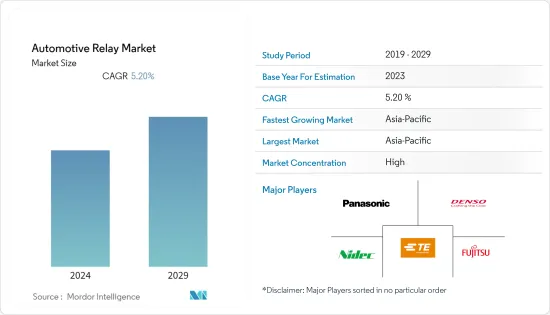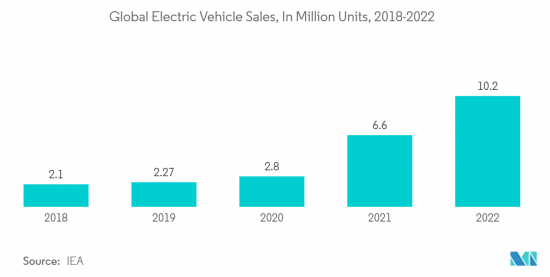
|
시장보고서
상품코드
1404076
세계 자동차용 릴레이 시장 - 점유율 분석, 산업 동향과 통계, 성장 예측(2024-2029년)Automotive Relay - Market Share Analysis, Industry Trends & Statistics, Growth Forecasts 2024 - 2029 |
||||||
자동차용 릴레이 시장 규모는 2024년 102억 3,000만 달러에서 2029년에는 131억 8,000만 달러로 성장하며, 예측기간(2024-2029년)의 CAGR은 5.2%를 나타낼 것으로 예측됩니다.

하이브리드 자동차와 전기 자동차 등 자동차의 전동화가 진행됨에 따라 다양한 전기 시스템을 제어 및 관리하는 릴레이 수요가 높아지고 있습니다. 또한 적응형 크루즈 컨트롤 및 차선 이탈 경보 시스템과 같은 ADAS 기능의 성장은 센서 및 액추에이터를 제어하는 릴레이에 의존합니다.
가볍고 고성능의 특성을 가진 선진적인 릴레이에 대한 수요에 의해 제조업체 각사는 종래의 무거운 전기 기계식 릴레이에 비해 보다 많은 솔리드 스테이트 릴레이의 생산에 투자하지 않을 수 없게 되었습니다. 이는 이 지역에서 하이브리드 자동차와 전기 자동차 수요가 증가하고 있기 때문입니다.
지역별로는 아시아태평양이 자동차용 릴레이 시장을 독점할 것으로 예측됩니다. 아시아태평양의 릴레이 시장은 주로 자동차 생산 및 판매 증가, 자동차 급속한 전기화, 배기 가스 규제 엄격화, 소비자 가처분 소득 증가로 인한 것입니다. 그 결과, 안전과 쾌적성을 요구하는 경향이 강해져, 자동차 수요가 증가하고 있습니다.
자동차용 릴레이 시장 동향
자동화 시스템의 보급이 전자 기기의 채용을 촉진
자동차 산업은 하드웨어에서 소프트웨어 대응 자동차로 전환하고 있으며, 자동차 1대당 소프트웨어와 일렉트로닉스의 평균 탑재량은 급속히 증가하고 있습니다. 전자 제품은 종종 새로운 기능과 특징을 자동차에 통합 할 수 있습니다. 따라서 파워트레인, 안전관리, 바디, 편의성 및 인포테인먼트 등 주요 응용분야에 일렉트로닉스의 침투가 진행되고 있습니다.
정부의 참여와 시스템의 자동 제어를 강화하고자 하는 소비자의 요구는 모두 자동차에서 전자사용 증가로 이어졌습니다. 일렉트로닉스는 에너지 효율과 배출가스 감소를 개선할 수 있는 새로운 기회를 제공합니다. 모든 차량 등급에서 자동차 전자 제품의 높은 보급률은 생산성, 품질 및 혁신의 세 가지 주요 측면에서 영향을 받습니다.
자동차 업계에서는 소비자의 운전 경험을 변화시키기 위한 노력이 전개되고 있습니다. 자동차는 더 현명해지고 자기 진단을 할 수 있습니다. 앞으로 몇 년동안 자동차는 효율적으로 연결할 수 있습니다.
또한 승무원의 안전성도 자동차의 자동 운전 시스템 채용을 촉진하는 요인 중 하나입니다. 자동차에 안전 기능과 시스템을 탑재하는 것은 지난 수십년동안 거리에서 사고와 사망자 수의 감소에 크게 기여해 왔습니다.
소비자의 안전성과 편리성을 확보할 수 있는 자율주행차나 스마트카(차량간(V2V) 통신이나 차량 인프라(V2I) 통신으로 접속하는 기능을 가진다)에 대한 주목이 높아지는 가운데, 신차에 탑재되어 하는 전자 시스템 수요가 급속히 증가하고 있습니다.
추진 요인 경험을 향상시키는 차세대 자동차 전자 제품은 중급차 및 엔트리 레벨 자동차 부문에서 대량으로 채택되어 애프터마켓을 통해 쉽게 이용할 수 있습니다.
현재 및 향후 출시되는 자동차에서는 전기 부품의 사용이 급속히 증가하고 있으며, 전기 부하를 효율적이고 안전하며 확실하게 전환할 수 있는 안정적이고 표준화된 부품의 제조 요구가 지속적으로 높아지고 있습니다. 이러한 요인이 현재 시장 성장을 견인하고 있습니다.

아시아태평양이 자동차용 릴레이 시장을 독점
아시아태평양은 세계 최대의 자동차 생산 기지이며, 이 지역에는 중국, 일본, 한국, 인도 등 주요 자동차 제조업체가 있습니다. 또한 소득 수준 상승, 도시화, 생활 수준 향상으로 아시아태평양 전역에서 자동차 보유 대수가 증가하고 있습니다. 이러한 자동차 보유량의 급증은 다양한 차량 시스템에 사용되는 자동차 릴레이 수요에 직접적인 영향을 미칩니다.
아시아태평양의 많은 국가에서는 공해 및 온실가스 배출을 줄이기 위해 엄격한 배기가스 규제를 실시했습니다. 이러한 규제는 효율적인 운영을 위해 릴레이를 사용하는 고급 엔진 관리 시스템 및 배기 가스 제어 시스템의 채택을 뒷받침합니다.
EV와 하이브리드 차량으로의 이동은 자동차 산업에서 중요한 동향입니다. EV와 하이브리드 자동차는 기존의 내연 엔진 차량에 비해 릴레이를 많이 사용하여 시장 성장에 기여하고 있습니다. 릴레이는 보다 컴팩트하게 통합되고 있어, 차내의 공간절약화와 경량화를 실현하고 있습니다. 이 추세는 경량화와 공간 최적화를 중시하는 자동차 산업의 움직임과 일치합니다.
아시아태평양은 자동차 생산의 주요 거점으로 자리매김하고 자동차 보유 대수 증가, 자동차의 전동화, 엄격한 규제, 선진 자동차 기술의 채용 등에 의해 자동차용 릴레이 시장을 선도하고 있습니다.
자동차용 릴레이 산업 개요
자동차용 릴레이 시장은 DENSO Corporation (ANDEN Co. Ltd), Panasonic Corporation, TE Connectivity, Nidec Corporation 등의 기업이 독점하고 있습니다.
이 지역에는 국제 릴레이 제조업체와 국내 릴레이 제조업체가 존재하기 때문에 자동차 릴레이 시장의 경쟁은 치열합니다. 각 회사는 R&D 프로젝트에 많은 투자를 하고 신제품을 발표하고 있습니다. 예를 들면
- 2022년 4월 LG Magna e-Power Train은 멕시코 라모스 앨리스페에 있는 최신 제조 시설을 발표했습니다. 이 신설 공장은 General Motors의 전기 자동차(EV) 제조 사업을 강화하는 것을 주 목적으로 인버터, 모터, 차재 충전기의 생산에 특화되어 있습니다.
기타 혜택
- 엑셀 형식 시장 예측(ME) 시트
- 3개월간의 애널리스트·지원
목차
제1장 서론
- 조사의 전제조건
- 조사 범위
제2장 조사 방법
제3장 주요 요약
제4장 시장 역학
- 시장 성장 촉진요인
- 자동차의 전동화의 진전
- 시장 성장 억제요인
- 정밀한 시험과 검증
- 업계의 매력 - Porter's Five Forces 분석
- 공급기업의 협상력
- 구매자/소비자의 협상력
- 신규 참가업체의 위협
- 대체품의 위협
- 경쟁 기업간 경쟁 관계의 강도
제5장 시장 세분화(시장 매출 단위:달러)
- 유형별
- PCB 릴레이
- 플러그인 릴레이
- 용도 유형별
- 잠금 시스템
- 엔진 관리 모듈
- 램프/라이트
- 기타 용도 유형(파워 윈도우, 선루프, ABS 제어 등)
- 지역별
- 북미
- 미국
- 캐나다
- 기타 북미
- 유럽
- 독일
- 영국
- 프랑스
- 기타 유럽
- 아시아태평양
- 중국
- 일본
- 인도
- 한국
- 기타 아시아태평양
- 세계 기타 지역
- 브라질
- 남아프리카
- 기타 국가
- 북미
제6장 경쟁 구도
- 벤더의 시장 점유율
- 기업 프로파일
- Robert Bosch GmbH
- DENSO Corporation
- Fujitsu Ltd
- Panasonic Corporation
- MITSUBA Corporation
- TE Connectivity
- Omron Corporation
- Hella KGaA Hueck & Co.
- Nidec Corporation
제7장 시장 기회와 앞으로의 동향
JHS 24.01.18
The Automotive Relay Market size is expected to grow from USD 10.23 billion in 2024 to USD 13.18 billion by 2029, registering a CAGR of 5.2% during the forecast period (2024-2029).
The increasing electrification of vehicles, including hybrid and electric vehicles, drives the demand for relays to control and manage various electrical systems. Also, the growth of ADAS features such as adaptive cruise control and lane departure warning systems relies on relays to control sensors and actuators.
The demand for advanced relays with lightweight and high-performance characteristics is compelling manufacturers to invest in producing more solid-state relays compared to traditional heavy electromechanical relays. It is owing to the growing demand for hybrid and electric vehicles in the region.
Among regions, Asia-Pacific is anticipated to dominate the automotive relay market. The Asia-Pacific relay market is primarily driven by growing vehicle production and sales, rapid electrification of vehicles, rising stringency of emission norms, and increasing disposable income of consumers. It, in turn, is increasing the demand for vehicles, owing to the growing preference for safety and comfort.
Automotive Relay Market Trends
Increasing Penetration of Automated Systems Driving the Adoption of Electronics.
The automotive industry is transitioning from hardware to software-enabled vehicles, and the average software and electronics content per vehicle is increasing rapidly. Electronics often enable the integration of new functions and features into the car. Thus, there is increasing penetration of electronics into major application fields, including powertrain, safety management, body, and convenience or infotainment.
Both government involvement and consumers' demand for greater automatic control of systems resulted in the increased usage of electronics in vehicles. Electronics are offering new opportunities to improve energy efficiency and emission reduction as several functions can be consolidated into fewer and smaller electronic control super units, thereby reducing the weight. The high penetration rate of automobile electronics across all vehicle classes is being influenced by three major aspects, namely, productivity, quality, and innovation.
Efforts are being deployed in the automobile industry to transform consumers driving experience. Cars are becoming smarter and capable of conducting self-diagnostics. In the coming years, cars can connect effectively.
In addition, passenger safety is another factor driving the adoption of automated systems in automobiles. The installation of safety features and systems in vehicles greatly aided in reducing the number of accidents and fatalities on the road over the past few decades.
With the increasing focus on autonomous vehicles and smart cars (with the ability to connect with vehicle-to-vehicle (V2V) and vehicle-to-infrastructure (V2I) communications) that can ensure safety and convenience to consumers, the demand for electronic systems in new cars is increasing rapidly.
Newer generation automotive electronics that enhance the driver experience are witnessing mass adoption in mid-range and entry-level car segments and ease of availability through the aftermarket.
The rapidly growing use of electric components in current and upcoming vehicles is consistently propelling the need for manufacturing reliable and standardized components for efficient, safe, and secure switching of electric loads. These factors are currently driving the market growth.

Asia-Pacific Dominating The Automotive Relay Market
Asia-Pacific is the world's largest automotive production hub, with several countries in the region, including China, Japan, South Korea, and India being major automobile manufacturers. Also, rising income levels, urbanization, and improved living standards led to an increase in vehicle ownership across Asia-Pacific. This surge in vehicle ownership directly impacts the demand for automotive relays used in various vehicle systems.
Many countries in Asia-Pacific implemented strict emission regulations to reduce pollution and greenhouse gas emissions. These regulations drive the adoption of advanced engine management and emission control systems that use relays for efficient operation.
The shift towards EVs and hybrid vehicles is a significant trend in the automotive industry. EVs and hybrids use more relays compared to traditional internal combustion engine vehicles, contributing to the market growth. Relays are becoming more compact and integrated, saving space in vehicles and reducing weight. This trend aligns with the automotive industry's focus on lightweighting and space optimization.
Asia-Pacific region leads in the automotive relay market due to its position as a major automotive production hub, growing vehicle ownership, the electrification of vehicles, stringent regulations, and the adoption of advanced automotive technologies.
Automotive Relay Industry Overview
The automotive relay market is dominated by companies such as DENSO Corporation (ANDEN Co. Ltd), Panasonic Corporation, TE Connectivity, and Nidec Corporation.
The market for automotive relays is highly competitive due to the presence of both international and domestic relay suppliers in the region. The companies are investing heavily in R&D projects and launching new products. For instance,
- In April 2022, LG Magna e-Powertrain announced its latest manufacturing facility located in Ramos Arizpe, Mexico. This newly established plant is dedicated to the production of inverters, motors, and onboard chargers with the primary objective of bolstering General Motors Electric Vehicle (EV) manufacturing operations.
Additional Benefits:
- The market estimate (ME) sheet in Excel format
- 3 months of analyst support
TABLE OF CONTENTS
1 INTRODUCTION
- 1.1 Study Assumptions
- 1.2 Scope of the Study
2 RESEARCH METHODOLOGY
3 EXECUTIVE SUMMARY
4 MARKET DYNAMICS
- 4.1 Market Drivers
- 4.1.1 Increasing Electrification of Vehicles
- 4.2 Market Restraints
- 4.2.1 Precise Testing and Validation
- 4.3 Industry Attractiveness - Porter's Five Forces Analysis
- 4.3.1 Bargaining Power of Suppliers
- 4.3.2 Bargaining Power of Buyers/Consumers
- 4.3.3 Threat of New Entrants
- 4.3.4 Threat of Substitute Products
- 4.3.5 Intensity of Competitive Rivalry
5 MARKET SEGMENTATION (Market value in (USD))
- 5.1 By Type
- 5.1.1 PCB Relay
- 5.1.2 Plug-in Relay
- 5.2 By Application Type
- 5.2.1 Locking System
- 5.2.2 Engine Management Module
- 5.2.3 Lamps/Lights
- 5.2.4 Other Application Types (Power Window, Sunroof, ABS Control, etc.)
- 5.3 Geography
- 5.3.1 North America
- 5.3.1.1 US
- 5.3.1.2 Canada
- 5.3.1.3 Rest of North America
- 5.3.2 Europe
- 5.3.2.1 Germany
- 5.3.2.2 UK
- 5.3.2.3 France
- 5.3.2.4 Rest of Europe
- 5.3.3 Asia-Pacific
- 5.3.3.1 China
- 5.3.3.2 Japan
- 5.3.3.3 India
- 5.3.3.4 South Korea
- 5.3.3.5 Rest of Asia-Pacific
- 5.3.4 Rest of the World
- 5.3.4.1 Brazil
- 5.3.4.2 South Africa
- 5.3.4.3 Other Countries
- 5.3.1 North America
6 COMPETITIVE LANDSCAPE
- 6.1 Vendor Market Share
- 6.2 Company Profiles
- 6.2.1 Robert Bosch GmbH
- 6.2.2 DENSO Corporation
- 6.2.3 Fujitsu Ltd
- 6.2.4 Panasonic Corporation
- 6.2.5 MITSUBA Corporation
- 6.2.6 TE Connectivity
- 6.2.7 Omron Corporation
- 6.2.8 Hella KGaA Hueck & Co.
- 6.2.9 Nidec Corporation



















